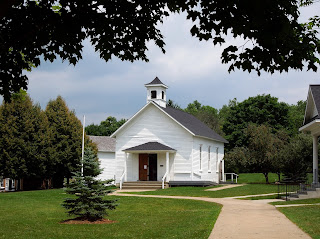A
Little History:
The St. Mary's River is the only water
connection between Lake Superior and Lake Huron .
During those early years, boats could not navigate through the rough rapids of
the St. Mary's River (a difference of 21 feet between Lake Superior and Lake Huron
lake levels). The laborious task of skirting
the rapids was solved when the first lock was built on the north shore of the
St. Mary’s River in 1797. That lock was destroyed during the War of
1812. It would be another
43 years before a replacement lock would be opened (1855) and once again ships
could pass between the two Great Lakes saving
time and money.
Information about the Locks:
- State
Lock (1855-1888) was 350’ long, 70’ wide, and 12’ deep.
- Weitzel
Lock (1881-1919) was 515’ long, 80’ wide, and 17’ deep
- Poe Lock (1896-1960’s) was 800’ long, 100’ wide, and 21’ deep
- Davis
Lock (1914) was 1,350’ long, 80’ wide, and 24’ deep
- Sabin
Lock (1919) was 1,350’ long, 80’ wide, and 24’ deep
- MacArthur
Lock (1943) was built at 32’ deep to meet the demands of bigger ships
- Poe Lock (1968) was 1,200’ long, 110’ wide, and 32’ deep
MacArthur Lock (East and West)
Get
Ready to Look at the Locks:
When you arrive at the Soo
Locks Park ,
your first stop should be at the Visitor
Center
FYI …even if the Visitor Center is not open, the park is open year round,
from 6 a.m. until midnight in the summer months, and from 6 a.m. until 6 p.m.
during the winter season. The locks are
closed between January 15th and March 25th. This allows workers to do maintenance and
other projects that can not be done during the regular shipping season.
Next, important piece of information – yes, there are restrooms BUT they
are not always open. We were in the park
after 10 p.m. one night when I discovered that fact!
While you are at the Visitor Center
Some Exhibits in the Visitor Center
The main event at the Visitor
Center
“Boats heading into Lake Superior
from the lower Lake Huron Level are described as being ‘upbound’ and will have
to be raised up 21 feet at the Locks. Boats going the other way, from the
higher Lake Superior level going towards Lake Huron
must be lowered down 21 feet at the Locks and are described as being
“downbound.”
"Upbound" Freighter
Once the freighter is secured inside the lock, it will take about 15-20
minutes for the boat to be raised or lowered (depending on the direction it is heading).
The public can watch the freighters and boats go
through the locks from a double-decker, semi-enclosed viewing platform. On the average, between 7,000- 10,000 ships
come through the locks each year.
Viewing Platform
Freighter & International Bridge
A few years ago, we took a cruise
through the Panama Canal (Pacific Ocean to the Atlantic
Ocean ). This is one of the
rare times that a Captain of a ship relinquishes control of his vessel. The Panama
pilots take over until the ship has completed its transit through Panama Canal waters.
Unlike the Panama
Canal , boats enter the Soo Locks under their own power.
Transit procedures state, “Most boats registered in the U.S. and Canada have captains and wheelsmen
who are fully qualified and licensed to operate on the St. Mary’s River and
through the Soo Locks. Foreign vessels bring on specially licensed Great
Lakes Pilots when they enter the waterway and this pilot brings them into the
locks.”
I wanted to photograph the International Bridge
"Upbound" Freighteer (far right of photo)
MacArthur Lock & International Bridge
For more information on the Soo Locks, please click on the
following link:
There are more things to do at the Soo. Refer to my Blog post on historic sites in
Sault Ste Marie by clicking on the following link:























































